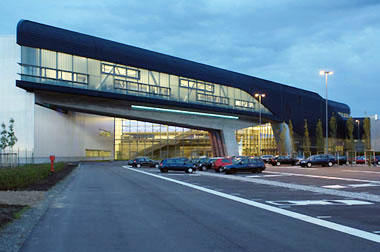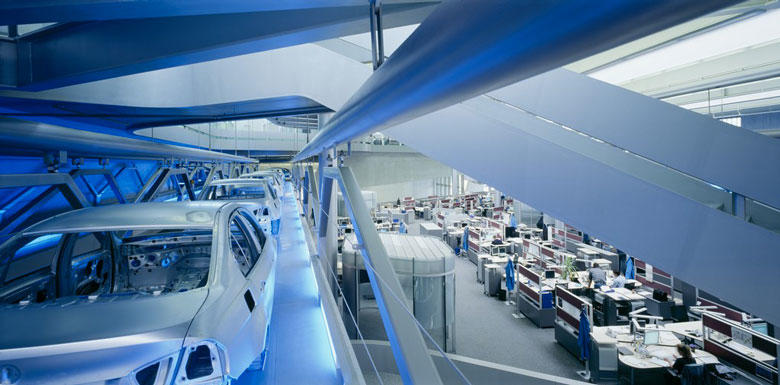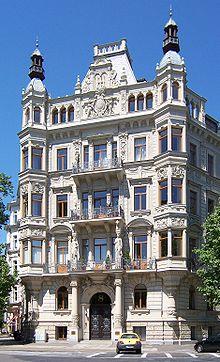Introduction
This paper provides a detailed scrutiny of BMW Central Building. The award-winning architect, Zaha Hadid, who was selected from more than 100 entries from other world’s leading architects following an open request to submit a building design for the company, designed the BMW Central Building. Before the erection of the structure, the plant had three disjointed houses, which assumed an important position in the construction process of the company. The three buildings separately housed the production of raw auto bodies (645,000 square feet), the paint shop (270,000 square feet), and the final assembly hall (1,075,000 square feet) (Jodidio 2).
The construction of the Central Building allowed the three buildings to be joined into a single complex. The competition for the construction of the Central Building aimed at attracting designs that would allow the buildings to be joined. In fact, the building complex would also house the administrative division of the company. The selection of Zaha Hadid’s design was informed by the evident creativity that allowed the bringing together of manufacturing, blue collar, and white collar roles in the company in a seamless manner (Kochan 111). It allowed visitors to interact with both administrative and manufacturing segments of the company. The complex is now the central nerve for the production facility in Leipzig Production Plant.


The company’s move to expand and modernize its production location in Leipzig was in line with its desire of cementing its position as a central car producer in Germany and across the world. Other competitors such as Audi and VW had already modernized their production facilities. All the key developments in the Germany automobile industry have allowed the country to position itself as a leading origin of top-notch vehicles to compete in the global automobile industry.
The BMW Central Building is noticeable from the previous structures on the location by its vibrant geometry that looks like the lightning lock. Further, interstitial rooms on the structure are set to suit court squares that add magnificence to the house. Employees and visitors all enter through the same door where an overhead conveyor for car bodies greets them since uncompleted car bodies zoom past the production line (Wittenburg 328).
The employees experience being part of the larger enterprise in the way the manufacturing and administrative roles are interconnected. Divisions were not apparent since the entire close to 800 workers in the Central Building from the boss to the apprentice has an indistinguishable computer unit. Concisely, the BMW Central Building is an indication of the power of modern architecture and technology.

Location of the Building
The BMW Central Building is located in Leipzig, Germany (Wittenburg 327). The building is part of the manufacturing complex for BMW, which is dedicated to the production of BMW 3 Series with a capacity of more than 650 vehicles per day. The plant is located on a 250-ha site in the capital (Bonfinger, Mayer, and Wollmershäuser 99). The plant, which combines the production processes and the daily administrative roles, employs more than 5,500 employees, thus making it the largest single employer in the town.

The plant was established in 2001. Its choice was informed by various reasons. Firstly, the plant is strategically situated between two main roads, namely, A9 and A14 autobahns. In addition, the municipality, which is a crucial location for other automobile production facilities such as Audi, is home to specialist personnel (Jodidio 8). Further, as a central industrial center, the city has an elaborate logistical providers and suppliers of input materials for the production of cars among other industrial activities.
The City of Leipzig is the fourteenth largest metropolis in Germany in terms of population. It is crucial to note that the capital is purposefully located in 160 kilometers from Berlin. Its location near Berlin makes it an important destination for many manufacturing companies that seek to expand their production capacities outside Berlin. The metropolis has a population of about 540000 people while its larger urban zone has a population of approximately 1.1 million residents (Gannon 12).
The metropolitan is located at the confluence of two rivers, namely White Elster and Parthe, and hence a further reason why it is strategic for key production companies due to the availability of water. It has an extensive history of being business heart since the times of Roman Kingdom. It is also located at the convergence of two main historical business paths, namely, Via Regina and Via Imperii. During World War II, the city was a significant urban center for East Germany. Its status as a cultural and economic center declined after the collapse of the country from the devastations of the war.
The town has experienced principal modifications, including the reinstallation of past structures and the destruction of others to pave a way for the construction of recent houses that now are characteristic of the municipality. It is also viewed as one of the most modern and livable cities in Germany. This situation is fueled by the influx of top-notch companies that wish to utilize its strategic location as a manufacturing hub in the country. The metropolis is served by foremost transport infrastructures, including road, rail, and air (Kochan 113). Its extensive transport network has eased the movement of people to and from work, hence further strengthening its position in the country (Gannon 9). It is also connected to other cities such as Berlin through a rail and road system, which further ensures that its strategic location is further strengthened.
The company is not only a primary production hub of BMW but also for other car manufacturing businesses such as Porsche and Audi. In 1921, the Versailles Armistice Pact authorized the company to stop its manufacture of planes. In 1921, the company shifted to the production of motorcycles before it evolved into automobile production in 1928. In the 1950s, the company ran into financial difficulties that made it almost functionless.
However, after overcoming the challenges of the time, the company managed to grow rapidly into one of the world’s leading vehicle manufacturers (Spencer 5). In addition, the town is currently the central base for DHL, the world’s leading parcels and logistics organizations. It relocated its activities from Brussels landing field to the Leipzig/Halle Airstrip (Jodidio 6). The metropolis is also the base for the European Energy Trade in Europe. Concisely, the location of BMW’s Plant in Leipzig is informed by strategic reasons that support the Germany automobile maker’s push for becoming the world’s leading auto manufacturer.
Culture and Society
The City of Leipzig is among the earliest developed regions in Germany. It was firstly recorded in 1015, meaning that it may have existed before the 11th century. In addition, it was first recognized as a capital and market in 1165. Over the centuries, the metropolis has been a key location for many events that have helped it to shape Germany, as it is today (Gannon 13). These events and the importance of the metropolis are well documented while others are evident in the culture and society of the location.
Firstly, the town is viewed as a principal architectural center that combines designs through the ages. For instance, the historical downtown of the metropolis features the renaissance style that traces its origins in the 16th and 17th centuries. There are evident houses from the baroque architectural period that signify the town as an important historic trade location and an attraction for rich merchants (Spencer 21). At least 30% of the city’s houses have the historical style of the Grunderzeit Era.

The economic boom in Germany in the 1990s ushered a new era of architectural designs that have now put the capital as a modern region in the country. Indeed, the period and housing boom of the 1990s was further facilitated by tax breaks, which followed the reunification of Germany (Kochan 113). Buildings that display its evolution from as early as the 16th century to the modern-day architecture dot the municipality where the BMW Central Building is a key part of the modern or 21st-century architecture.
The metropolitan is also a central musical center in Germany. Historically, the Church has played a crucial role in the development of music in the municipality. For example, one of the key people in the development of music in the country was Johann Sebastian Bach who worked with the St. Thomas Church Choir from 1723-1750 (Wittenburg 329). Felix Mendelssohn also opened “the first musical conservatoire in Germany in the City of Leipzig” (Gannon 23). The conservatoire is currently part of the University of Music and Theater Leipzig where students are taught about music. The university attracts students and musicians from all over the world. These developments show the importance of the town as a musical location.
The city is a significant location of modern art. It has played an important role in defining Germany’s contemporary arts. For instance, the launch of Neo Rauch five years ago at Leipzig was a crucial step towards strengthening the municipality as a main arts base (Jodidio 9). The Grassi historical facts base further provides a vital art anthology from the metropolis, including the Ethnography Gallery and the Musical Apparatus Exhibition as an evident fete of the historical significance in Leipzig.
The municipality is also a key educational hub in Germany. For instance, Leipzig University, which was formed in 1409, is one of the world’s oldest institutions of higher learning. It has trained main scholars and Nobel Prize winners (Spencer 42). Indeed, the current Chancellor of Germany, Angela Merkel, is an Alumnus of the University. However, the institution has a conservable population of only 30,000 learners. The Germany Foundation of Journalism is part of the Leipzig Institution of Higher Education. It has further trained many writers in the contemporary period (Jodidio 46). Other notable universities in the city include the University of Music and Theater Leipzig, Leipzig University of Applied Sciences, and several research institutes owned by the Max Planck Society.
The town’s population and economy depend on the manufacturing sector, which is very vibrant as compared to other sectors. For instance, the capital is the hub of many manufacturing companies such as BMW, Porsche, and others, which employ thousands of people. However, other foremost companies such as DHL, financial service companies, and other small retail companies also contribute to the economy of the metropolis.
Amazon is also located in the metropolitan as its hub in Germany and Eastern Europe. Due to its excellent economy, it attracts both professionals and technical people to serve the various segments of the economy. Further, its people have some of the highest incomes in the country (Gannon 26). Its elaborate infrastructure and strategic locations are the key factors for attracting the influx of manufacturing companies. Lastly, due to the vibrancy of the economy, it currently enjoys the leading position as having the best quality of life for its people in Germany.
Construction of the Building
The construction of the BMW Central Building was part of the strategic plan of BMW of modernizing its operations by not only adopting new technologies but also its facilities to reflect its chief goals of becoming a leader in innovation in the automobile segment. The building is part of a larger manufacturing complex, which is responsible for the production of BMW 3 series vehicles (Jodidio 14). The process of the construction of the building began with a call for architectural designs, which would merge the three existing building complexes into one structure to bring together the manufacturing and administrative roles in a manner, which would allow the employees to recognize their role as part of a larger company.
In many cases, companies separate their administrative functions from the manufacturing segment, thus leading to the two segments existing unmindful of the other. Thus, BMW sought to overcome the problem by trying to bring together the existing building complexes, which had separated the roles of administration and manufacturing (Wittenburg 336). The call for the architectural designs attracted more than 25 award-winning architectural firms to compete for the design, which would take BMW’s Leipzig Plant to the next level. After long-standing deliberations, the design by Pritzker Prize, the award-winning architect, Zaha Hadid, was chosen in 2002.

The construction of the building began immediately after the BMW’s management board adopted the winning design. The award for the construction of the building went to Arge Rohbau and OBAG/Wolf & Mueller GmgH (Gannon 3). The structural engineer of the construction of the building was AGP Arge Gesamtplanung.

The construction of the building utilized the leading technology in architecture. To realize the complex design, the project was steered by well-experienced engineers. The budget of the building was more than $30 million, thus adding a significant cost to the more than $1 billion complexes that were already in place (Jodidio 4).
The groundbreaking ceremony of the building was done in March 2003 after the contracts for the central construction companies were awarded and all the necessary paperwork and financing was discussed. The assembly began with the Steel construction, which was completed in January 2004. In March 2004, the enclosing of the building and the roofing was completed (Wittenburg 327). In September, the car park was completed. The car park is located in front of the housing complex for ease of access by the employees and members of the public. In September 2004, the Central Building was completed. In May 2005, the landscaping of the area was completed. The building was opened for use.

Concisely, the completion of the building complex brought together the manufacturing, the pub, and administrative roles of the company. Presently, the building is one of the best architectural designs and monuments in Germany. Indeed, in line with the company’s design to bring people into the picture, the building attracts numerous people who seek to experience the architectural prowess depicted in the building. The building has won numerous awards since its completion.
Building the Structure Today
It is worth noting that the Central Building at BMW’s Leipzig Plant is a contemporary structure, which has lasted only ten years since its inception. The building was constructed at a time when computer technology was gaining momentum in the construction and architecture industries. Since the establishment of this structure, many developments have been made in the construction and architecture technologies. Firstly, if the construction of the building took place today, it would have taken a shorter duration due to the advancement in the construction technologies that allow construction process to be undertaken in a shorter duration.
In addition, it would have taken less labor due to the advancement in the construction machinery, which can replace many people while doing multiple tasks. On the other hand, the architectural design would have utilized new technologies that are provided through software such as CAD, which allows the designs to be completed on computers with higher precision. Concisely, although the building is still contemporary, the fast technological developments seen today would have allowed a faster completion and a more elegant design than what the technology of the time offered. It would have probably cost less due to more utilization of machinery and technologies that replace the costly human labor.
Conclusion
Based on the expositions in the paper, it suffices to declare the BMW Central Building an important depiction of the company’s quest of becoming a leader in its operations. The building, which cost more than $30 million, was finalized in 2005. It was part of Zaha Hadid’s architectural designs. The designer out-performed more than 25 other architectural entries of the time. In the end, the building brought together people, employees, and manufacturing processes in a seamless way that allowed BMW to position itself as a technological leading company in its operations.
Works Cited
Bonfinger, Peter, Eric Mayer, and Timo Wollmershäuser. “The BMW model: A new framework for teaching monetary economics.” The Journal of Economic Education 37.1 (2006): 98-117.Print.
Gannon, Todd. Zaha Hadid: BMW Central Building Source Book in Architecture 7, Princeton, CA: Princeton Architectural Press, 2006. Print.
Jodidio, Philip. Architecture and Automobiles, Shanghai, China: Images Publishing, 2011. Print.
Kochan, Anna. “BMW innovates at new Leipzig assembly plant.” Assembly Automation 26.2(2006): 111-114. Print.
Spencer, Douglas. “Replicant urbanism: the architecture of Hadid’s Central Building at BMW, Leipzig.” The Journal of Architecture 15.2(2010): 181-207. Print
Wittenburg, André. “Building an integrated IT governance platform at the BMW Group.” International Journal of Business Process Integration and Management 2.4(2007): 327-337. Print.